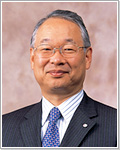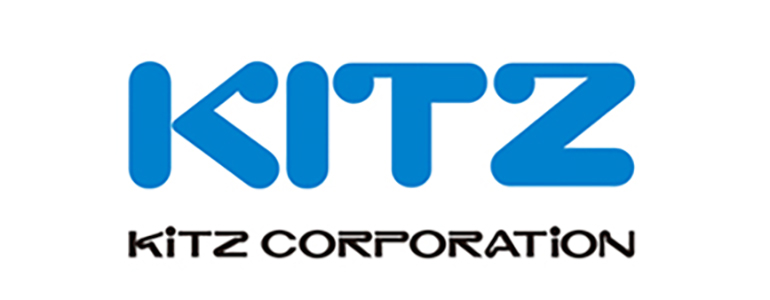| KITZ (6498) |
|
||||||||
Company |
KITZ CORPORATION |
||
Code No. |
6498 |
||
Exchange |
TSE 1st Section |
||
Industry |
Machinery (Manufacturing) |
||
President |
Yasuyuki Hotta |
||
HQ Address |
1-10-1 Nakase, Mihama-ku, Chiba, 261-8577, Japan |
||
Year-end |
March |
||
URL |
|||
* Share price as of closing on November 8, 2011. Number of shares outstanding as of most recent quarter end do not include treasury shares.
ROE and BPS are calculated by using actual amounts during or at the end of the previous term.
|
||||||||||||||||||||||||
|
|
* Estimates are those of the Company.
Mail: kitz@cyber-ir.co.jp |
|
| Key Points |
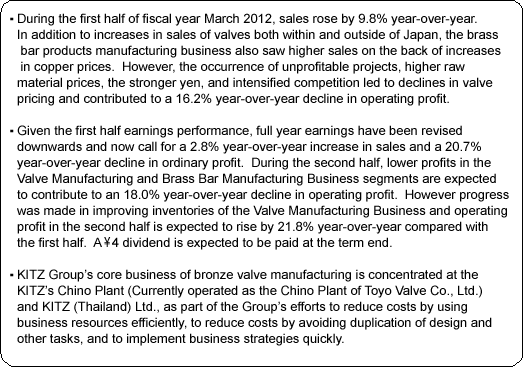 |
| Company Overview |
|
<Overview of KITZ' s Business Segments>
KITZ' s business is divided into the Valve Manufacturing, Brass Bar Manufacturing, and Other Business segments. During fiscal year March 2011, each of these divisions accounted for 72%, 19% and 9% of total sales respectively.
Valve Manufacturing Business
The KITZ Group' s core business is the manufacture and sale of valves, connectors and other fluid control devices that play important roles in fresh and sewage water distribution, water heating, gas supply, and air conditioning applications, as well as in various applications within the petroleum, chemical, paper and pulp, semiconductor and other industries.
Brass Bar Manufacturing Business
In the business KITZ combines copper with zinc to create brass, tin and phosphorous to create phosphor bronze, and nickel and zinc to create nickel silver, which are then used in the dissolving, casting, rolling, pulling, forging, or cold forming processes to create sheets, strips, pipes, bars, wires and other forms. The KITZ Group' s brass bar business uses the raw material of brass to manufacture and sell brass bars. These brass bars are used not only as materials for valves, but also in the manufacture of water faucets, gas equipment, electrical appliances and other various products.
Other
KITZ operates sports and fitness clubs, hotels and restaurants, and sells glass art work within this segment.
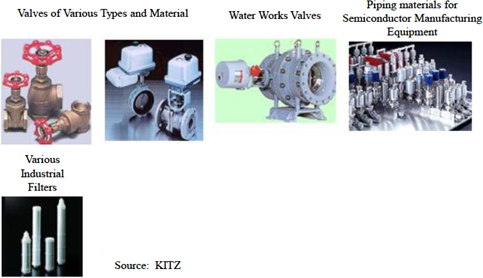 |
| First Half Fiscal Year March 2012 Earnings Results |
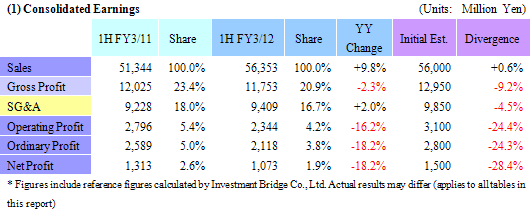 Sales Rise 9.8%, Ordinary Profit Fall 18.2%
Sales rose by 9.8% year-over-year to ¥56.35 billion. While sales of the fitness club and hotel businesses declined because of the negative impact of the Great East Japan Earthquake, sales of the main business of valve manufacturing rose both inside and outside of Japan. In addition, Brass Bar Manufacturing Business sales also rose due in part to the rise in copper prices. However, orders for products for large plants applications in the Middle East negatively impacted profits. Furthermore, rises in raw material prices, the strong yen, and intensified competition led to declines in valve pricing and caused operating profit to fall by 16.2% year-over-year.KITZ assumptions for foreign currency called for an exchange rates of ¥81.77 per US Dollar, (Actual rate of ¥91.02 in the previous term), and ¥115.98 per Euro (Actual rate of ¥119.24 in the previous term). Also the Company used a price assumption of ¥771,000 per ton (¥681,000 per ton in the previous term) for electrolytic copper. 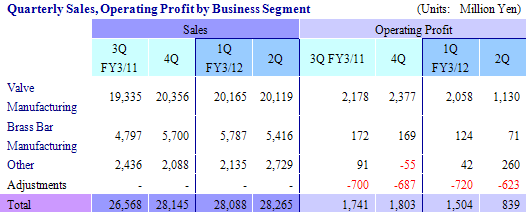 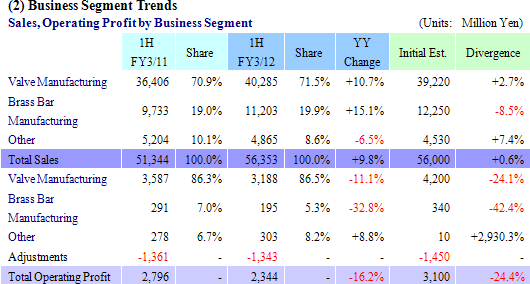 Valve Manufacturing Business
Sales growth in both Japan and overseas markets allowed Valve Manufacturing Business segment sales to rise by 10.7% year-over-year to ¥40.28 billion. Domestic sales grew by 7.0% year-over-year to ¥27.44 billion. By market application, sales to fresh and sewage water (Up by 25% year-over-year), machinery and equipment (Up by 4.0% year-over-year), and general chemical and gas related applications all rose. At the same time sales to the semiconductor industry rose by a small margin (Sales in the second quarter along fell in terms of both year-over-year and half-over-half), and sales to the petroleum refining and petrochemical industries remained in line with the previous year' s levels. In addition, sales to construction facility applications rose on the back of recovery demand in the wake of the earthquake (Dealers stockpiling inventories) during the first quarter. However the disappearance of this recovery demand led to weaker sales as inventory adjustments were made, contributing to a marginal decline in first half sales. Sales to overseas markets rose by 19.5% year-over-year to ¥12.84 billion. Sales to China grew by 56% year-over-year, and to Thailand and Indonesia by 20% year-over-year due to a continuation of strong demand seen during the previous term. Increases in orders in the latter half of the previous fiscal year led to a 38% year-over-year increase in sales to North America. At the same time, the negative impact of the sovereign debt issues in Europe led to stagnant demand in those markets and sales declined by 10% year-over-year.Valve Manufacturing Business segment profit declined by 11.1% year-over-year to ¥3.18 billion. While this segment realized higher sales and cost reductions, unprofitable orders from large plant applications in the Middle East, higher raw material costs, and weaker product pricing were major factors behind the decline in profits. Brass Bar Manufacturing
While sales rose due in part to the volatility in the copper market, Brass Bar Manufacturing profits declined. Specifically sales rose by 15.1% year-over-year to ¥11.20 billion on the back of higher product pricing due to higher copper prices. However lower translation gains on materials (Due to volatility in copper prices in the current term compared with the steady rise in prices in the same term of the previous year), valuation losses due to sudden drop in copper prices, and increases in labor costs in response to increased production caused this segment' s profit to decline by 32.8% year-over-year to ¥190 million.
Other
The negative impact of the earthquake upon the fitness club and hotel operations caused sales to decline by 6.5% year-over-year to ¥4.86 billion. However efforts to reduce costs in the fitness club operations (Reductions in electricity and sales promotions) allowed this segment' s profit to rise by 8.8% year-over-year to ¥300 million. Moreover the earthquake forced KITZ to temporarily suspend fitness clubs operations in Mito and Sendai (Reopened in June) and led to cancelations by group reservations in its hotel operations.
(3) Group Companies Business Trends
On a non-consolidated basis, sales rose by 7.3% year-over-year to ¥27.16 billion, while operating and ordinary profits declined by 67.5% and 48.2% year-over-year to ¥400 and ¥900 million respectively. While recovery demand led to increased sales, valuation losses and disposal losses from large plants applications in the Middle East compounded declines in prices and increases in material prices.With regards to subsidiaries, sales of Toyo Valve Co., Ltd. and Shimizu Alloy Mfg. Co., Ltd. products to construction and water related applications rose on the back of recovery demand. However improvements in profitability at Shimizu Alloy Mfg. Co., Ltd. due to increases in utilization rates were offset by a marginal decline in profits at Toyo Valve Co., Ltd. due to lower product prices. In overseas markets, both sales and profits of KITZ (Thailand) Ltd. grew by large margins on the back of the strong economies around Asia. Expansion in sales at KITZ Corporation of Jiangsu Kunshan (China), which had seen slow demand in plant and energy related applications in the previous term, allowed profitability to improve by a large margin. The large increase in sales of Perrin GmbH (Germany) allowed it to turn profitable. Strong growth in sales of KITZ Corporation of America also allowed it to double its profits. In addition, KITZ SCT Co., Ltd., which supplies products to the semiconductor industry, saw a marginal rise in sales, but profitability deteriorated due to weaker market conditions. KITZ METAL WORKS CORPORATION, which manufactures brass bars, recorded growth in sales and a decline in profits. KITZ Wellness Co., Ltd. saw an increase in profits despite a decline in sales due to successful efforts to reduce costs. Hotel Beniya Co., Ltd., hotel operation, recorded declines in both sales and profits. 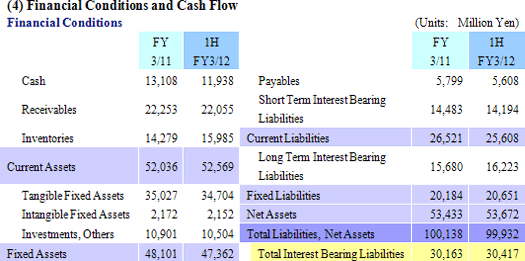 With regards to cash flow, increases in inventories and declines in payables led to a large reduction in operating cash flow. Despite restraint in capital investments, free cash flow turned to an outflow of ¥860 million, which compares with an inflow of ¥1.12 billion seen in the previous term. A net outflow was seen in financing cash flow due to the reductions in interest bearing liabilities, and cash and equivalents fell by ¥1.05 billion from the end of the previous term to ¥11.64 billion.  |
| Fiscal Year March 2012 Earnings Estimates |
 Full Year Earnings Revised Down, Sales Expected to Rise 2.8%, Ordinary Profit to Fall 20.7%
While sales of the Valve Manufacturing Business segment are expected to remain in line with previous year' s levels due to the disappearance of recovery demand in the second half, sales of Brass Bar Manufacturing Business are expected to decline on the back of weaker copper prices. With regards to profits, the stronger yen, changes in sales composition, and weaker prices are expected to lead to a decline in profits of the Valve Manufacturing Business. At the same time, the Brass Bar Manufacturing Business is expected to also see lower profits due to weaker copper pricing. Consequently KITZ calls for operating profit to fall by 18.0% year-over-year to ¥5.2 billion. However compared with the first half, profits of the Valve Manufacturing Business are expected to rise by 32.1% half-over-half during the second half on the back of improvements in inventories. Consequently consolidated operating profit is expected to rise by 21.8% half-over-half. KITZ also projects a dividend payment of ¥4 per share at the end of the term for a total full year dividend payment of ¥7.5 per share when combined with the dividend paid at the end of the first half.
  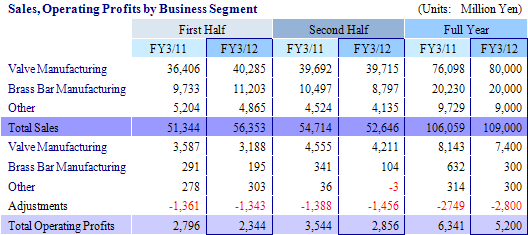 (2) KITZ Group Efforts to Fortify Management Structure and Improve Service Levels
In June 2011, the Kawagoe Factory, which was operated by Miyoshi Valve Co., Ltd. as a brass and bronze valve manufacturing facility, was closed and the production function was transferred to KITZ. In January 2012, the manufacturing divisions of Toyo Valve Co., Ltd. is expected to be spun off from the marketing division and transferred to KITZ. Thereafter Toyo Valve Co., Ltd. will become a company specifically focused upon marketing of products. These moves are designed to create a stronger group management structure, with the manufacturing function of brass and bronze valves being concentrated at the two facilities of KITZ Chino Plant (Currently the Toyo Valve Co., Ltd.' s Chino Plant) and KITZ (Thailand) Ltd. as a means of optimizing the use of business resources, and reducing costs by eliminating duplication of design functions.In addition, a marketing subsidiary called KITZ Corporation of Asia Pacific Pte. Ltd. was established in Singapore in October 2011. This company is designed to function as a marketing office specifically focused upon various markets around the Asia Pacific region, which is an important market identified in the "KITZ Global Vision 2020" long term business plan. Therefore this company is expected to serve a crucial function in the expansion of earnings in the Asia Pacific region. |
| Conclusions |
|
Despite the disappearance of earthquake recovery related demand, overall demand for products is expected to remain firm as the long term recovery efforts are still in play. At the same time, while conditions in Europe are expected to remain severe, a continuation of favorable conditions in Asia and Oceania, and North America are expected to allow orders to grow. The influence of the earthquake disaster and unprofitable projects are expected to have finished (While difficult to assess the pace of the recovery going forward), and earnings are believed to have bottomed in the first half and should recover going forward. Disclaimer
This report is intended solely for information purposes, and is not intended as a solicitation to invest in the shares of this company. The information and opinions contained within this report are based on data made publicly available by the Company, and comes from sources that we judge to be reliable. However we cannot guarantee the accuracy or completeness of the data. This report is not a guarantee of the accuracy, completeness or validity of said information and or opinions, nor do we bear any responsibility for the same. All rights pertaining to this report belong to Investment Bridge Co., Ltd., which may change the contents thereof at any time without prior notice. All investment decisions are the responsibility of the individual and should be made only after proper consideration.Copyright(C) 2011, All Rights Reserved by Investment Bridge Co., Ltd. |

